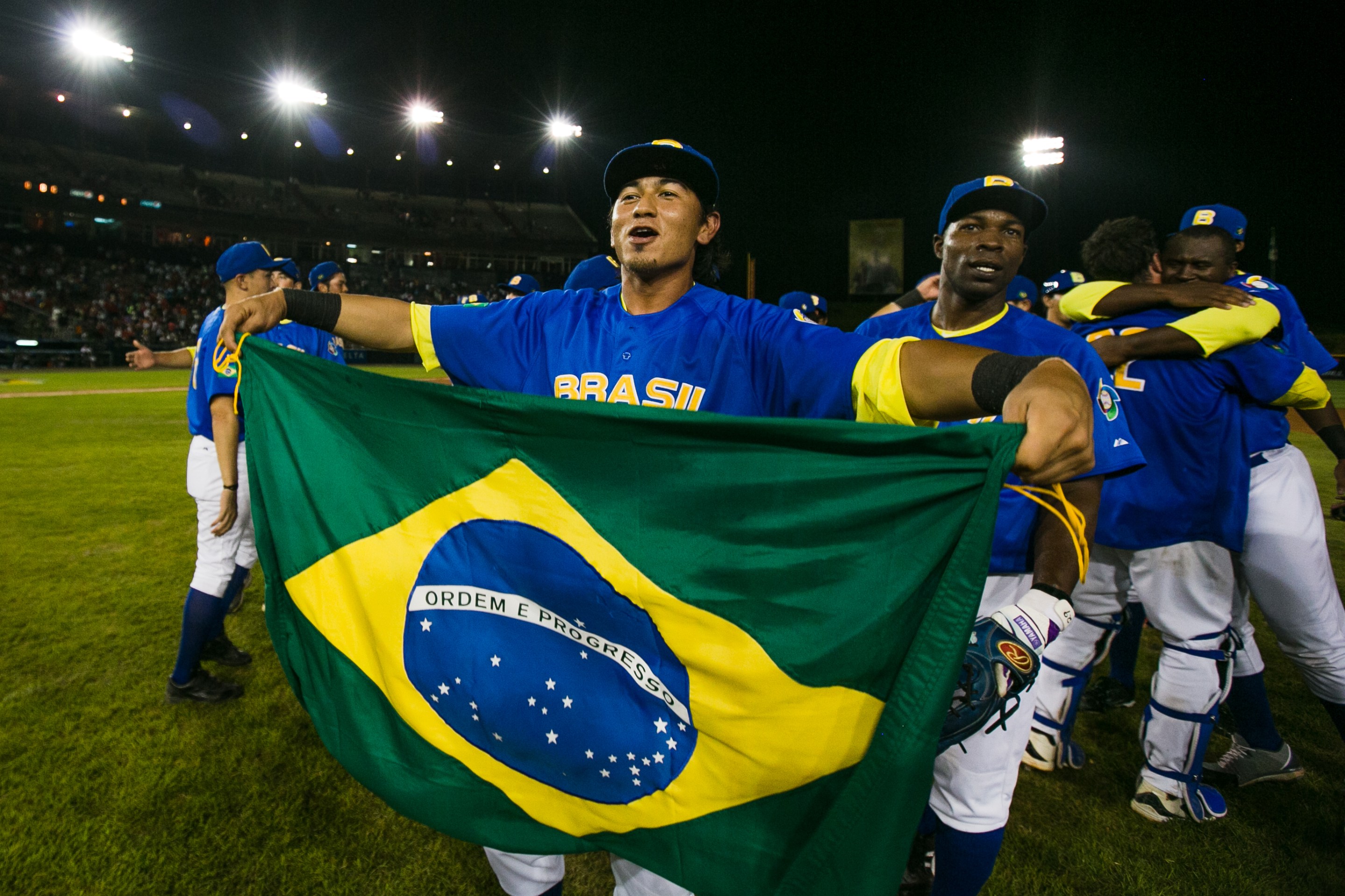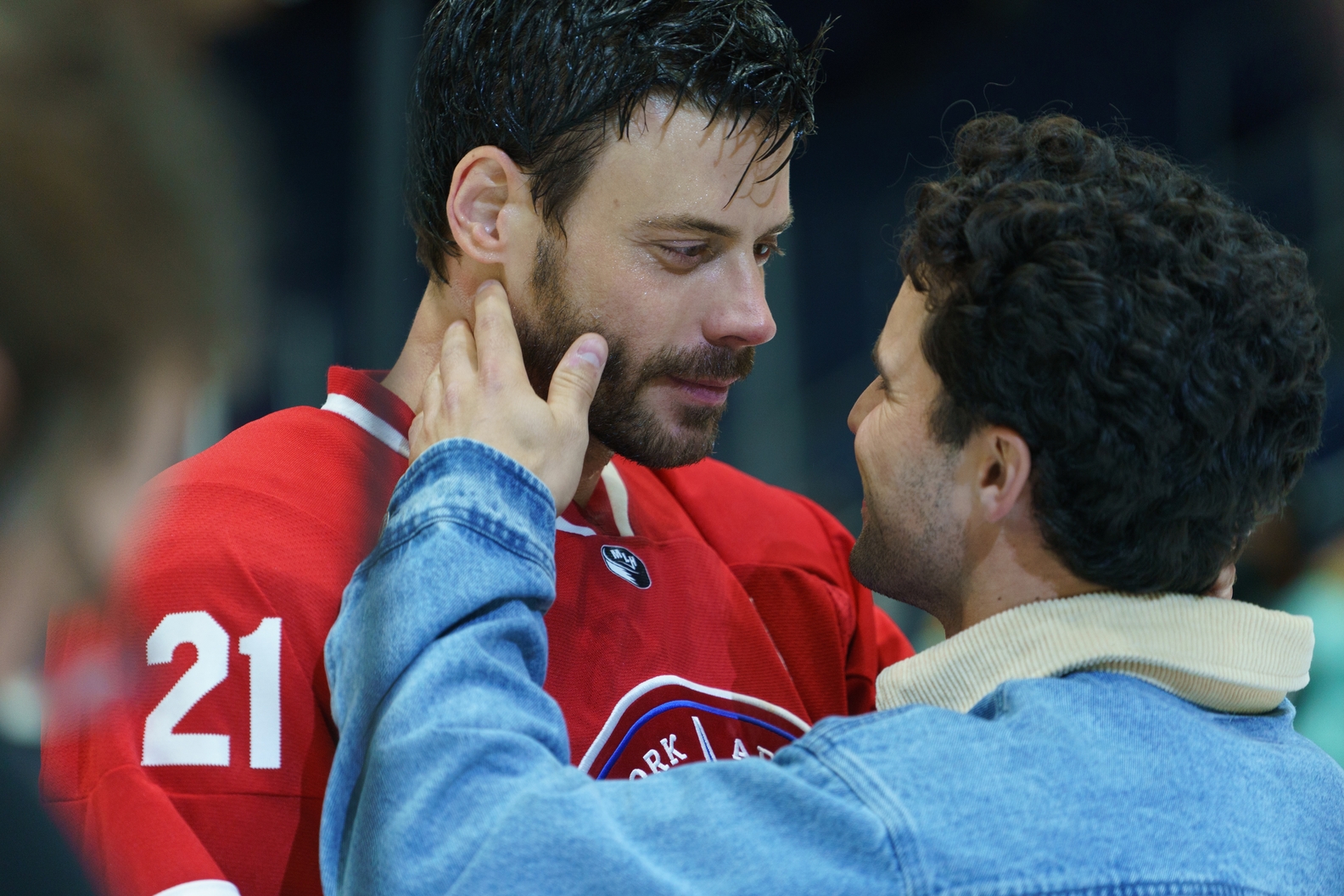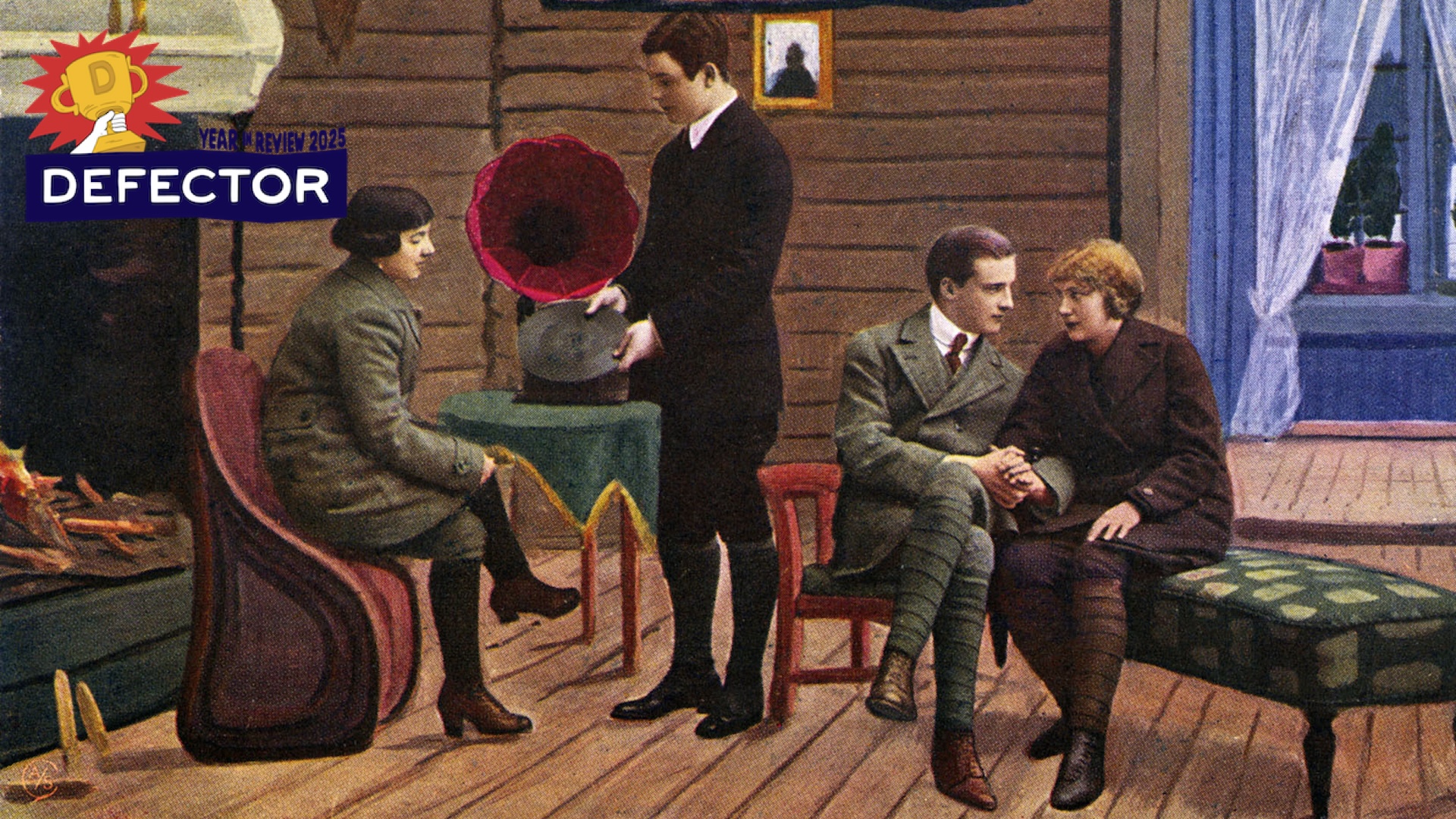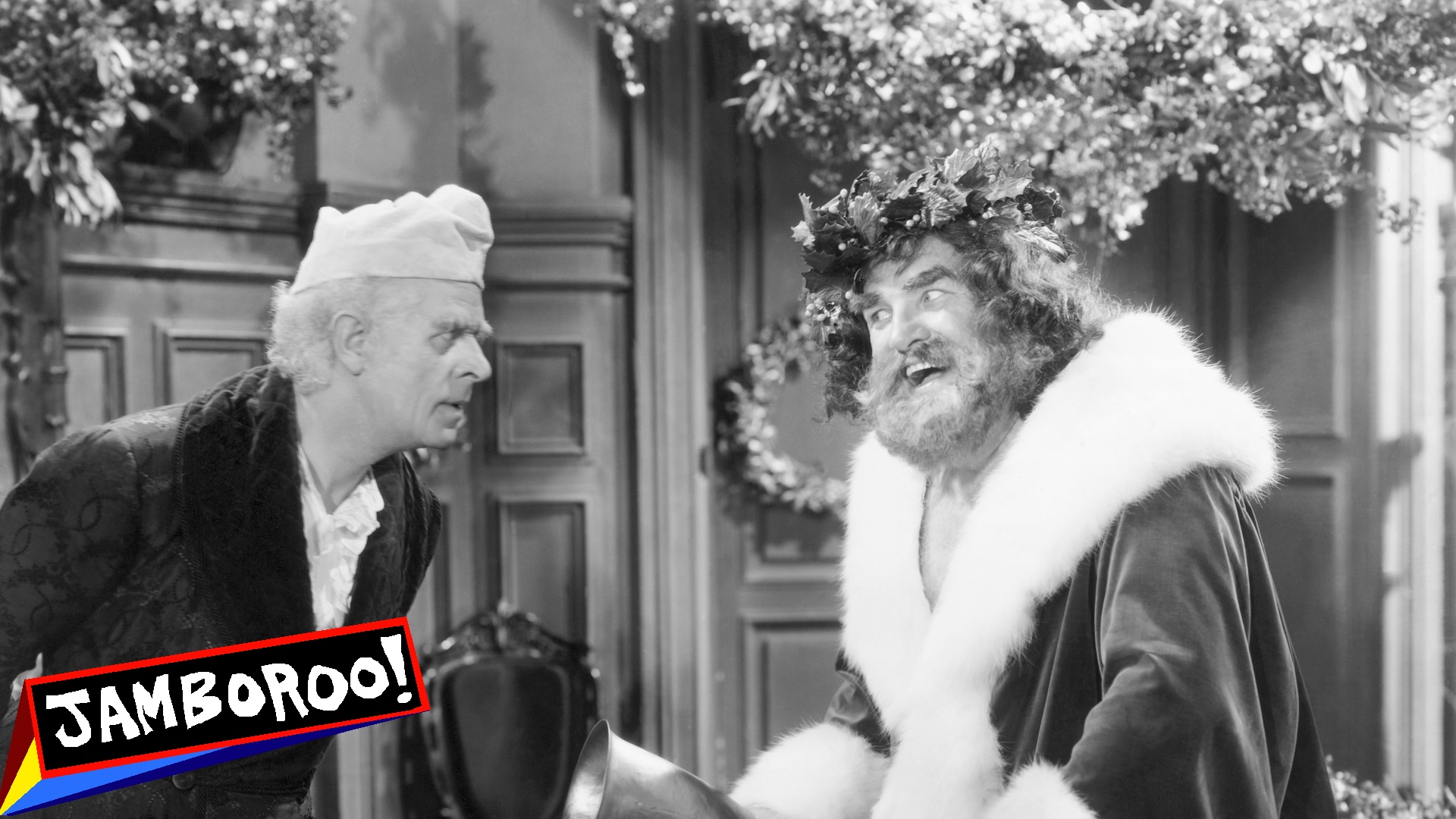SÃO PAULO — Most of the 45-minute drive felt familiar. You follow the Marginal Tietê and then President Dutra highway out of São Paulo, the same route that I’d taken dozens of times over the last two decades from the city center to Guarulhos International Airport, where almost all international flights arrive and depart. But, this time, we turned off the highway, and the roads and towns became smaller and the buildings farther in-between. A few minutes after the road turned to dirt, the baseball fields came into view.
We had arrived at GECEBS, one of a handful of baseball and softball clubs founded by Japanese Brazilians around metropolitan São Paulo, early on a foggy Saturday morning. Driving was Márcio Irikura, the chief of the delegation to the Brazilian national baseball team for the upcoming Pan-American Games in Santiago, Chile. Now a dentist, Irikura grew up playing baseball in Pereira Barreto, a town in the far west of the state of São Paulo founded by Japanese immigrants. He represented Brazil in international competition, before becoming active in the Brazilian Confederation of Baseball and Softball (CBBS), the governing body that oversees baseball in Brazil. I was there to watch one of the monthly practices for Brazil-based players looking to make the Pan-Am Games roster. Because players in the Pan-American Games must be at least 19 years of age, the majority of the roster consists of older Brazil-based players. Of those present at the practice, most had graduated from the confederation’s youth academy before playing professionally overseas, many in the United States or Japan, and have since returned to Brazil, where they now play for various club teams at the highest level of baseball in Brazil. Two players named to the final 24-man roster, outfielder Paulo Orlando and pitcher André Rienzo, even played in the Majors.
The life of a ballplayer in Brazil, where there’s no professional league, looks far different than it does in the United States. As the disproportionate number of Japanese surnames on the national team roster suggests, the history and development of Brazilian baseball is, in many ways, a history of the country’s relationship with Japan. Today, Brazil is home to the largest Japanese community outside of Japan; more than a million and a half Nikkei, people of Japanese descent, reside in the country. The vast majority of those, about a million, live in the state of São Paulo; over 350,000 reside in the city of São Paulo alone. As a result, Brazilian baseball culture has been heavily centered in the state of São Paulo and the northern part of the neighboring state of Paraná, which also saw large-scale agricultural settlement of Japanese. While there are teams that play in other parts of the country, including in the Amazon where some Japanese settled, all 19 of the Brazil-based players selected for the 24-man Pan-American Games roster play in southeast Brazil.
The majority of teams in youth and adult competitions in Brazil belong to baseball clubs founded by Japanese immigrants. In the interior of the state, these clubs often carry the name of their communities, like Marilia and Atibaia (the two finalists in this year’s Brazilian championship). In metropolitan São Paulo, baseball clubs usually belong to Nikkei cultural associations and play at baseball complexes located on the outskirts of the metropolitan area, where land for building baseball fields is cheap and plentiful. GECEBS, for example, traces its history to 1958, when a group of friends from Bastos, founded as a model Japanese Brazilian agricultural colony in the 1920s and itself a Brazilian baseball powerhouse, decided to establish a club of their own closer to their new home in the city of São Paulo. Similarly, two others, the Nippon Blue Jays of Nippon Country Club and the Anhanguera Nikkei Club, own baseball complexes about an hour outside the city to which most players commute from the city on weekends for practice and games.
The demographics of Brazilian baseball have been shifting over the years; today, about half of players are non-Nikkei. But those non-Nikkei players who end up playing baseball usually have grown up in communities with large Nikkei populations and strong baseball cultures. Others refer to chance encounters that led them to learn the game through Nikkei neighbors and friends. When I spoke with Jean Tomé, an outfielder on the national team and former Mariners minor league pitcher, he explained that he was first introduced to baseball growing up in Atibaia, because he lived across the street from the town’s batting cage, which was owned and operated by a Japanese Brazilian.
Just as in Japan, the earliest history of baseball in Brazil was American. Baseball was introduced to Brazil in the late 19th century, around the same time that soccer arrived from Europe. The first recorded baseball games were played among American expatriates in Rio de Janeiro, but in a testament to the city’s growth and industrialization in the early 20th century, São Paulo quickly became the center for Brazilian baseball culture. American expats and missionaries formed local teams that helped grow the game, in much the same way that British expatriates had brought soccer to the country. In the 1910s, sports clubs in São Paulo, some of which are now world famous for soccer, routinely hosted baseball competitions as well. The Correio Paulistano, one of the city’s major daily newspapers, reported on games between teams composed primarily of American expatriates representing industrial companies like the Canadian-founded São Paulo (Tramway) Light and Power. If history had gone differently, we might be able to imagine a world in which “jogo bonito” refers to a globally-known style of Brazilian baseball.
Japanese Brazil’s embrace of baseball reflected the rapid growth of the sport in Japan in the early 20th century. The first Japanese had arrived in Brazil in 1908, as coffee plantation laborers, following in the footsteps of earlier European immigrants. The first organized Japanese baseball teams in Brazil were found not in the rural areas where most immigrants settled, but in the city center itself, where a smaller, more elite Japanese community had begun to grow. By the late-1910s, Japanese youth organizations in the city were promoting the sport, and by the early-1920s, the Mikado Sports Club was one of the better known baseball teams in the city. The earliest surviving Japanese-language Brazilian newspapers show how even in these early years Japanese Brazilian interest in baseball was deeply tied to their former homeland. In the Burajiru Jihō, one of São Paulo’s Japanese-language newspapers, articles detailing the Mikado Club’s games appeared alongside news reports from Japan about college baseball games, especially the Sokeisen, the rivalry between Waseda and Keio University rivalry that was considered the most important game in Japanese baseball.
The number of Japanese migrants to Brazil remained fairly small during the earliest years; fewer than 30,000 arrived between 1908 and 1919. It wasn’t until the early-1920s when the Japanese government, which believed that rural Japan was overpopulated, began financing the large-scale emigration of its own citizens that larger numbers of Japanese farming families began arriving in São Paulo. Through its state-run migration company, the International Development Company (Kaigai Kōgyō Kabushiki Kaisha in Japanese), the Japanese government helped arrange for the emigration of almost 150,000 Japanese to rural São Paulo between 1920 and 1941. While the majority still arrived and worked in coffee plantations, the expectation amongst these new immigrants was that, instead of returning to Japan at the end of their contract, they would buy their own land in agricultural communities in the Brazilian countryside.
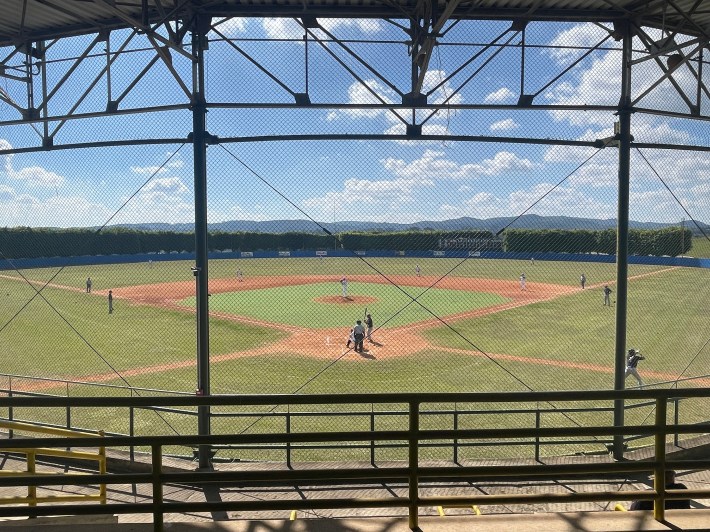
The sport of baseball grew alongside this Japanese population, and while the city of São Paulo remained the cultural and economic center of Japanese Brazil, the Brazilian baseball world transformed from being mostly made up of foreign expats in the state capital to one dominated by Japanese Brazilian agricultural communities in the interior. By the late-1920s, there were enough Japanese baseball clubs that regional competitions began to form along the various railroads that formed the axes of development in the states. Often named after the railway lines (e.g. Sorocabana, Noroeste, and Paulista), these competitions provided competition for Japanese youth and adults. Today, many of these teams remain powers in Brazilian baseball.
The growth of the Japanese population in Brazil happened to coincide with the growth in baseball’s popularity in Japan. For example, when Babe Ruth and a team of Major Leaguers famously toured Japan in 1934, the Japanese wire service story made it into all of Brazil’s Japanese-language newspapers. The existence of baseball in Brazil was even used to sell would-be emigrants on the possibilities of life in Japanese Brazil. The International Development Company, for example, published photographs of its Registro Colony’s baseball team alongside pictures of Japanese schoolchildren and agricultural life in the colony. Baseball was seen as both an important symbol of continuities between life in Japan and life in rural Brazil and a vehicle for promoting Japanese cultural values. In 1936, the first all-Brazil baseball championship was held in São Paulo, with most of the teams traveling to the capital from the interior. Later prewar editions of the tournament brought Japanese Brazilian teams to the city to compete for the national title. It didn’t last.
The Brazilian Revolution of 1930 that brought strongman Getulio Vargas to power had immense repercussions for both Japanese immigration and the sport of baseball in Brazil. As part of a broader attempt to take political and economic power from the state of São Paulo, Vargas banned foreign immigration and restricted the economic rights of immigrants. He implemented a new constitution in 1934 that included a strict two-percent entry quota, modeled on the United States’ own Immigration Act of 1924, which effectively ended Japanese immigration. In 1937, when Vargas declared himself dictator of his new Estado Novo government, he set out about a series of Brazilianization campaigns targeting immigrant groups that, among other things, made it illegal to publish in and teach foreign languages. Baseball, as a non-Brazilian sport so closely linked to the Japanese community, became a source of controversy in itself, especially after Brazil entered World War II on the side of the Allies in 1942. Organized baseball all but ceased during the war; some histories of Brazilian baseball suggest that baseball fields in Japanese communities were repurposed entirely.
When World War II ended, the Japanese community in rural São Paulo became embroiled in sectarian violence. Cut off from Japan during the war, a small number believed that Japan had actually won the war (kachigumi) and committed a number of violent attacks against those who recognized Japan’s defeat (makegumi). This violence included a number of high profile political assassinations against prominent members of the Japanese community and brought to the fore questions about the Japanese community’s place and future in Brazil. Whether Japanese Brazilians, especially Brazilian-born youth, should play baseball was one of those.
For a while, anyway—by the end of the year, regional competitions had resumed, both in the city of São Paulo and various parts of the interior, compelling the establishment of The São Paulo State Federation of Baseball and Softball. The 1950s through ’70s represented a golden era for Brazilian baseball. Notably, the establishment of the Estádio Municipal de Beisebol Mie Nishi, a permanent baseball stadium in the Bom Retiro neighborhood of São Paulo, finally gave Brazilian baseball a symbolic home in the capital. For teams in the interior of the state, a visit to the capital for the finals of the Brazilian championship was a major prize in and of itself. The stadium, which is still in use today and seats 2,500, was inaugurated on June 21, 1958 to commemorate the 50th anniversary of Japanese immigration to Brazil.
The stadium’s opening was a festive affair, attended by the governor of the State of São Paulo, Ademar de Barros; Princess Mikasa, today the oldest living member of the Japanese royal family; and the Waseda University baseball team, who had been flown to the country to play a number of exhibition games against a team of Brazilian all-stars. When I visited the Estadio Mie in August, I watched the final outs of a youth tournament between the São Paulo Gigantes (named for NPB’s Yomiuri Giants) and the Nippon Blue Jays (more on this shortly). The parents chanting and cheering in unison reminded me more of a Japanese baseball game than an American one, and even after a closely contested game, both teams gathered at home plate to bow to one another and the fans. That bowing, which echoes the practice of high school athletes in Japan’s famed Koshien Tournament, is found at almost all levels of Brazilian baseball, including the national club championships.
This golden age of Brazilian baseball coincided with Japan’s postwar reemergence as an economic power. Not only did the Japanese government restart its prewar emigration machine—it helped some 50,000 additional Japanese emigrate to Brazil between 1953 and 1963—but Brazil, and São Paulo especially, became an important site for Japanese business. As the Japanese community in Brazil grew larger and older, second- and third-generation Nikkei began moving from the interior to the city in growing numbers. Baseball clubs like Gigantes and GECEBS were formed in the city. Japanese companies also became important sponsors for Brazilian baseball clubs in the 1960s and ’70s, much as they do in Japan today. Company teams like Howa, Kanebo, Toshiba, and Mizuho Bank dominated Brazilian club baseball during this period, though many of these companies had stopped fielding teams by early-1980s. The postwar years also marked Brazil’s first forays into international competition, including sending a team to the first Pan American Games in Buenos Aires in 1951 and hosting the fourth edition of the games in São Paulo in 1963, with games played at Estádio Mie Nishi. Brazil won the first South American Baseball Championship in 1957 and even won three consecutive titles in the early 1970s, before that competition took a three-decade hiatus. Brazil qualified for this year’s Pan-American Games by winning last year’s South American Championship in Lima, Peru.
Not surprisingly, Brazilian baseball entered into a bit of a crisis in the late-1980s and early-1990s, as many Nikkei in Brazil moved to Japan to take advantage of an immigration program that provided Brazilian labor to Japanese firms, primarily in manufacturing. At one point, almost 300,000 Brazilians, primarily of Japanese descent, were living in various parts of Japan. Many of those who moved to Japan hailed from communities in the interior with rich baseball traditions, which led to a shortage of athletes at both the youth and adult levels. But many of those Japanese Brazilians were also exposed to higher levels of competition in Japan on local high school and community teams, and have since returned to become regular contributors over the years to the national team. Today, as Nikkei emigration to Japan has slowed and the populations of formerly Japanese towns in the interior have become more heterogeneous, baseball teams in Brazil have also grown their participant pool by introducing non-Nikkei to the sport.
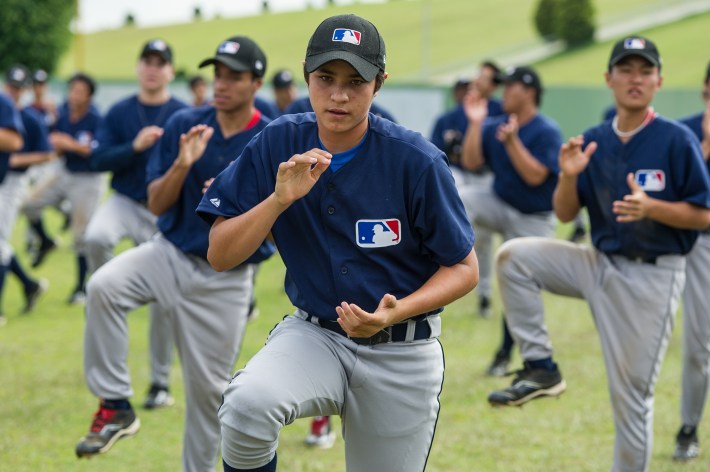
Brazilian baseball’s big breakthrough on the MLB radar came in 1992, when 16-year-old José Pett signed with the Toronto Blue Jays as an international free agent for a then-record $760,000 signing bonus. Pett’s signing came just two years after the founding of the CBBS, which was designed to create a national governing body, akin to the CBF, Brazil’s football federation. While previously there had been a few Japanese Brazilian players who had made it to Japan to play professionally, mostly in industrial leagues, Pett’s signing marked the first time that MLB scouts had descended en masse on Brazil to sign an international free agent. As Irikura told me, his club team in Brazil adopted the name “Blue Jays” in his honor, with the permission of the Toronto franchise; after merging with the Nippon Country Club, the Nippon Blue Jays remain one of the largest baseball clubs in Brazil, fielding teams from the youth to the adult levels. Pett’s photo is displayed on the walls of the outdoor cafeteria next to Nippon Country Club’s baseball facilities.
When General Manager Pat Gillick, who had led the Blue Jay’s signing of Pett, later became GM of the Seattle Mariners, the Mariners became one of the more active teams in scouting Brazilian youth players. For a long time, the team even sponsored the Brazilian junior club championship, the prime age group for scouting soon-to-be international free agents. It was called the “Copa Seattle Mariners.”
Just as baseball’s popularity has risen and fallen depending on Japanese interest in Brazil, the CBBS’s recent efforts to professionalize baseball in the country have also depended on the interest and largesse of outside groups interested in promoting Brazilian baseball. In the late-1990s, the president of the Brazilian division of Yakult, the Japanese beverage company and owner of NPB’s Swallows, offered to build a complex of baseball fields for the CBBS. They bought land in Ibíuna, about 40 miles outside of São Paulo, and the CT Yakult is now the main hub for organized Brazilian baseball. As Jorge Otsuka, longtime president of the CBBS, told me, shortly after the complex opened in 1999, the head of Yakult Brasil was frustrated that the complex, which includes five fields and lodging to house visiting teams and their families, was not being put to use besides for weekend tournaments. And so the CBBS and Yakult, together, established the first full-time baseball academy in Brazil.
Today, some 50 players between the ages of 13 and 18 reside at the academy, living away from their families during the week to concentrate on baseball and school. Players are invited based on their performance with youth teams, and spend their weekends returning to their hometowns, where they compete with their local clubs; some drive six or seven hours each way. For most, the CT Yakult compound provides the only opportunity to practice baseball every day, not to mention under the tutelage of foreign coaches with high-level experience, including from Cuba.
Tomé is himself an early graduate of the academy; he now also works as an MLB scout in Brazil. He says that the training center rivals comparable facilities run by MLB teams in the Dominican Republic. But there’s one crucial difference: unlike Brazilian soccer academies run by professional clubs, athletes at the CBBS-run academy must find a way to pay the monthly tuition. For some, that means finding a sponsor; in Tomé’s case, that was the president of his local baseball club in Atibaia. Until COVID, MLB also provided financial support to the CBBS to help run the academy, which in turn defrayed tuition for some players. Otsuka says MLB’s financial support for the academy will be returning soon.
For a country with such a small baseball community, the academy has proven highly successful at developing players who now play overseas. Each year, five or six academy players find their ways abroad, with the best signing with Major League teams. As international free agents, Brazilians are not subject to the amateur draft and can sign as they turn 16. A few Brazilian players have even garnered large signing bonuses; Luiz Gohara, who was born in Bastos and made the majors with Atlanta, signed with the Seattle Mariners for $880,000 in 2012; Eric Eiji Pardinho, also from Bastos and a member of the Pan-Am Games roster, became Brazil’s first million-dollar arm when he signed with the Toronto Blue Jays for $1.4 million in 2017.
For most Brazilians, the first stop on their minor league journeys is the Dominican Republic, and only after further development and success might they make it stateside. For those who don’t sign with MLB teams, some, especially Japanese Brazilian players, find their way to Japan, where they might play for industrial league or university teams. National team catcher Solomon Koba, for example, a graduate of the CT Yakult who grew up playing for the Nippon Blue Jays, played for the Kochi Fighting Dogs in Japan’s Shikoku Island League Plus before returning to Brazil. He’s now studying to be a dentist while still playing on weekends for the Blue Jays. A growing number of academy graduates have also begun playing college baseball in the United States.
Even the most talented Brazilian players face unique obstacles in pursuing overseas success. To Otsuka, the lack of opportunities for high level competition, even at the academy, have made it harder to develop Brazilian players. Southeast Brazil is quite distant from the rest of the baseball-playing world, and the weak Brazilian Real makes sending teams to international tournaments difficult. Tomé adds that Brazilian players tend to start playing baseball much later in life than their peers; he himself started at age 12. This not only makes it difficult to identify and scout players, but when a Brazilian player does reach a MLB farm system, they often have far less experience and coaching than their international peers.
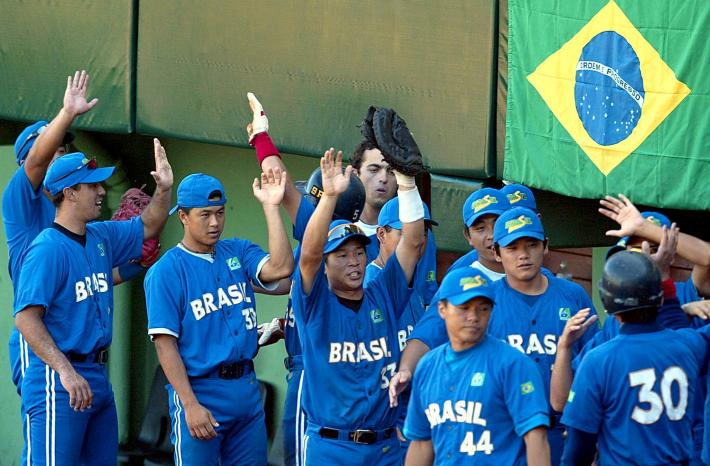
From his own experience, Tomé also noted that the adjustment to going overseas can be particularly jarring for Brazilian players. Far from home and in a new linguistic environment, Brazilian players, especially those who sign at 16, often find themselves struggling with the non-baseball parts of life. At the academy, players are taught English, both for their own education and as a necessary workplace skill for their baseball futures. In our conversation about his own experience, Tomé also noted a bit of cultural tension that he believes makes professionalizing baseball difficult in Brazil. He observed that for most Japanese Brazilians, playing baseball was about teaching youth about their heritage and important life skills—the importance of hard work, say, or being a part of a team. Non-Nikkei players, he went on, start with the aspiration to play professionally, and are far more willing to specialize in the sport from a young age.
In my conversation with Tomé, I wondered if part of this cultural divide might also be socioeconomic. Nikkei in Brazil, especially those living in the city of São Paulo, are relatively wealthy; playing baseball, with its club memberships and specialized equipment, is expensive. Nikkei parents and youth who can afford to play baseball may also have interests or expectations outside the game. Even if they are willing to commit to spending their weekends playing baseball, entering the CT Yakult academy at age 13 or 14 and living away from friends and family to concentrate on the sport, may seem an impossible choice. Over the years, the relative number of Japanese Brazilian players at the academy has been decreasing. Today that group represents less than half of athletes, though this development is also a reflection of a greater number of non-Nikkei players taking up the sport.
Even as a growing number of Brazilian players have found roster spots overseas, and even in the Majors, baseball remains a niche sport in Brazil. In our conversation, Otsuka observed that there were practical impediments to growing the game. São Paulo is one of the most populous cities in the world and space is at a premium. The lack of baseball fields in the city proper aside from the Estadio Mie means that baseball players can often only practice on the weekends. Even at the tee-ball level, baseball can become a weekend-long affair, requiring players and their parents to devote their Saturdays and Sundays to the sport. As Irikura noted while showing me around the capacious facilities at Nippon Country Club about an hour outside of the city, one of the reasons for the Blue Jays’ relative success has been the facilities that the club offers for parents. They can enjoy the club’s pools, tennis courts, and restaurants while their kids practice on the fields nearby. More baseball-focused local clubs, like GECEBS and Anhanguera, cannot offer that.
As a result, the best youth players in Brazil often come from the interior, in places like Marilia and Bastos, where baseball fields are more easily accessible and teams can practice during the week. The lack of a significant baseball-playing public also means that there is also no domestic manufacturer of baseball equipment. Bats, gloves, and balls must either be formally imported, and thus subject to Brazil’s punitive import tariffs, or brought in personal luggage to Brazil. Baseball players ask their friends to bring them back equipment when they travel overseas, in much the same way other Brazilians do computers and electronics. While I was visiting the CBBS headquarters in São Paulo, some of the confederation staff were excited to show Otsuka a shipment of bats that had finally arrived from overseas.
While comparatively few Brazilians play baseball, especially at the youth level, Brazilian access to and interest in Major League Baseball has never been greater. Big League games are routinely broadcast on ESPN Brasil and other sports channels. While in São Paulo, I visited The Pitchers Burger and Baseball, the only baseball-themed restaurant in the city. Located in the Zona Sul, a neighborhood popular with middle-class Japanese families, The Pitchers is a sort of Brazilian baseball mecca, and a gathering place for players, fans, and the curious.
When I arrived at The Pitchers to meet Márcio Irikura and his son Miguel, who had recently returned to Brazil from studying abroad in Indiana and plays for the Nippon Blue Jays, I was introduced to Jun Sato, one of the restaurant’s owners and an Irikura family friend. Sato and his business partners had grown up playing for the Anhanguera Nikkei Club, alongside former Major Leaguer Paulo Orlando; when Orlando’s Royals made it to the World Series in 2015, an earlier version of the restaurant was featured in the Kansas City Star. Orlando’s stateside career ended in 2019, but he still plays for Ananghuera. Sato proudly showed me a large framed team photo, which hung on the walls alongside pennants and plaques of various Major League teams; a chain-link fence separated a section of the restaurant in a way that recalled a batting cage. Just inside the entrance of The Pitchers is a collection of baseball jerseys on hangers. They are from professional teams around the world, each donated by Brazilian players who had gone overseas to play the game. From Japanese industrial leagues to Major League jerseys, the collection shows the diversity of experiences that Brazilian baseball players have enjoyed in baseball.
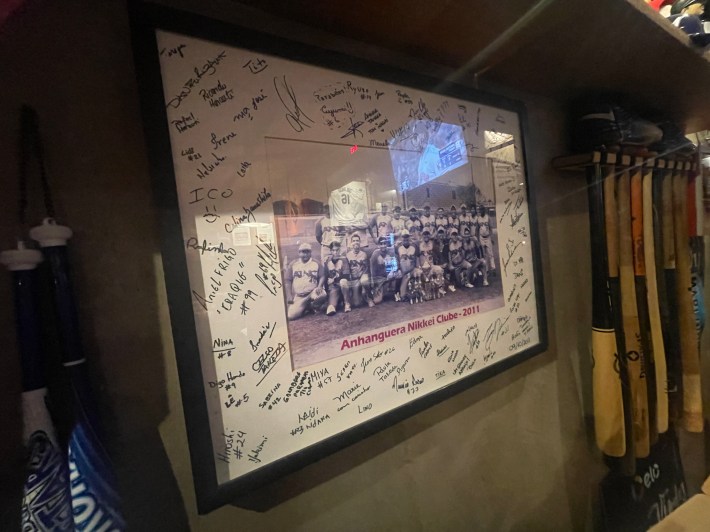
Over hamburgers and beer, with a television playing a regular season Diamondbacks-Giants game in the background, we discussed the history and experience of playing baseball in Brazil. Miguel talked about spending his senior year of high school in Indiana, the first time he’d had the opportunity to play baseball everyday. When I mentioned that I’d been surprised by the Japanese traditions of bowing to their opponents after games that are an integral part of baseball in Brazil—at Nippon Country Club, youth teams even come into the cafeteria after practice to bow to parents and staff while yelling out “Arigato Gozaimasu,” or thank you in Japanese—Miguel observed that he’d been surprised by the casual way his American teammates treated their field and their equipment; either due to the game’s Japanese values or the difficulty of getting new equipment, Brazilian players were much more careful.
At one point, the people dining at the table next to us got up and began trying on the jerseys hanging in the display. A running joke in the Brazilian baseball community is that despite the ubiquity of New York Yankees hats in São Paulo, no one knows that they’re hats worn by a baseball team. I wondered how many visitors to the restaurant thought of baseball more as a symbol of American culture than a sport to be watched or played.
Baseball culture in Brazil appears to be changing, with the focus of the game shifting away from historically Japanese Brazilian institutions and toward American baseball. The number of Brazilians who have been exposed to the game in adulthood, either by traveling to the United States or watching on television, has never been larger. At Arena Beisebol, a training center in the north zone of the city where Tomé also works, there are classes for adults learning to play for the first time; hobbyist clubs for adults have also begun to form. Major League Baseball has again started outreach efforts in the country following a hiatus during COVID, hoping to grow the game with youth in places beyond São Paulo. A recent MLB Players Alumni Association tour, part of MLB’s Project Beisbol outreach initiative, visited Belo Horizonte and Recife, in addition to Ibiúna.
But these MLB-backed projects pale next to another factor—a growing number of Venezuelans have come to Brazil, many settling in the north of the country. In Boa Vista, the capital of the northern state of Roraima that borders Venezuela, for example, newly-arrived immigrants have begun creating leagues and playing the game in local parks. Throughout Brazil, the influx of Venezuelans fleeing that country’s political and economic instability has brought baseball to new areas. Some of the best talent is already finding its way into the existing pipeline of Brazilian baseball, including the CBBS Academy.
Brazil’s biggest international baseball moment came in the qualifiers of the 2013 World Baseball Classic, when a team that included now-Cubs catcher Yan Gomes made a Cinderella run to qualify for the tournament, beating Panama in the final at Rod Carew Stadium in Panama City, 1-0. Gomes, the most famous and best established Brazilian major leaguer, moved from outside São Paulo to Florida at age 12, and is not considered a product of the Brazilian baseball system despite representing the country internationally.
In Tokyo, the Brazil team, which was by then without Gomes—he had been traded that offseason from Toronto to Cleveland and chose to concentrate on his own career, which was just getting going—lost all three games in pool play. The first two were to baseball powers Japan and Cuba, but giving up 5 runs in the bottom of the eighth inning to blow a late lead against China proved calamitous. With a win, Brazil would have qualified for the 2017 WBC. Instead, they have failed to qualify for the last two tournaments.
The visibility of Brazilian baseball has also suffered from the strange and haphazard treatment of baseball in the Olympic Games. The sport was removed from the Summer Olympics after the Beijing Olympics in 2008, only to reappear for the Tokyo Olympics, in 2021, before being removed from the slate again. Baseball was just reintroduced for the 2028 Games in Los Angeles. The loss of Olympic baseball barely registers to most fans, as Major Leaguers and NPB players do not participate, but the removal of the sport has had considerable impact on smaller baseball confederations, like the CBBS, which depend on their national Olympic committees for financial support. With the sport’s removal, the CBBS lost more than money; they also missed an opportunity to showcase the sport and the national team to a domestic audience when Rio de Janeiro hosted the Games in 2016.
The Pan-American Games are an important international tournament for the Brazilian Confederation, and one of the few in the international baseball world for senior players. For professional baseball and to most fans, though, it’s a second-tier competition. Pro teams are under no obligation to release players for national team duty; if they do, they may do so with significant restrictions to avoid injury. Only two players on the roster currently play in the United States, Pardinho and pitcher Gabriel Barbosa, also of Bastos, who played last season for the Single-A Fresno Grizzlies in the Colorado Rockies farm system. The Brazilian team will have its work cut for them in Santiago; in the opening round, they were drawn into a group against traditional baseball powers like Colombia, Cuba, and Venezuela. But international baseball games are only seven innings long, and baseball is a sport of flukes and surprises. Last Thursday, Brazil delivered one with a 3-1 win over Venezuela in their first game of group play; on Sunday, they did it again with a victory over Colombia. The history of Brazilian baseball is living proof that stranger things have happened.
